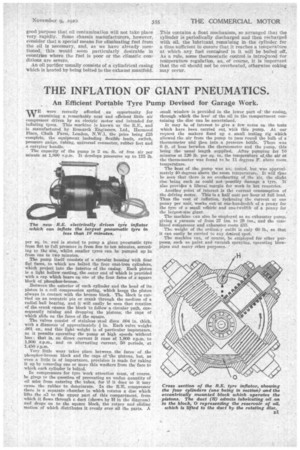THE INFLATION OF GIANT PNEUMATICS.
Page 91

If you've noticed an error in this article please click here to report it so we can fix it.
• An Efficient Portable Tyre Pump Devised for Garage Work.
WE were recently afforded an opportunity for examining a remarkably neat and efficient little air compressor driven by an electric motor and intended for inflating tyres. .This machine is known as the R.E., and is manufactured by Research Engineers, Ltd., Biarmood Place, Chalk Farm, Loudon, N.W.1, the price being £25 complete, the equipment including flexible leads, switch, pressure garige, tubing, universal connector, rubber feet and a carrying handle.
The capacity of the pump is 2 cu. ft. of free air per minute at 1,800 r.p.m. It develops pressures up to 175 lb.
per sq. in. and is stated to pump a giant pneumatic tyre from flat to full pressure in from five to ten minutes, according to the size, whilst smaller tyres can be pumped up in from one to two minutes.
The pump itself consists of a circular housing with four fiat faces, to which are bolted the four cast-iron cylinders, which project into the interior of the casing. Each piston is a light hollow casting, the outer end of which is provided with a cap which bears on one of the four fates of a square block of phosphor-bronze.
Between the exterior of each cylinder and the head of its piston is a coil compression spring, which keeps the piston always in contact with the bronze block. The block is carried on an eccentric pin or crank through the medium of a radial ball bearing, and it will easily be seen that rotation of the crank causes the block to follow a circular path, consequently raising and dropping the pistons, the caps of which slide on the faces of the square.
The valves consist of stainless tel discs .004 in. thick, with a diameter of approximately in. Each valve weighs .001 oz., and this light weight is of particular importance, as it permits operating the pump at high speeds without loss: that is, on direct current it runs al 1,800 r.p.m. to 1,900 r.p.m., and on alternating current, 50 periods, at 1,450 r.p.m.
Very little wear takes place between the faces of the phosphor-bronze block and the caps of the pistons, but, as 'even a Tittle is of importance, provision is made for taking it up by removing one or more thin washers from the face to which each cylinder is bolted.
In compressors for tyre work attention must, of course. be givep to the question of preventing an -undue quantity of oil mist from entering the tubes, for if it does so it may cause the rubber to deteriorate. In the R.E. compressor there is a separate chamber in which rotates a disc which lifts the all to the upper part of this compartment, from which it flows through a duet (shown by H in the diagram) and drops on to the square block, the rotary and sliding motion of which distributes it evenly over all the parts. A
mall window is provided in the lower part of the casing, through which the love' of the oil in the compartment containing the disc can be ascertained.
It may be of interest to give a few notes on the tests which have been carried out with this pump. At our request the makers fixed up a small testing rig which allowed the air from the pump to pass round the bulb of a thermometer arid then into a pressure bottle. There was 6 ft. of hose between the thermometer and the pump, this being the usual length supplied. After pumping for 10 minutes at 120 lb. per sq. in. the temperature of the air at the thermometer was found to be 11 degrees P. above room temperature.
The heat of the pump was no:, tested, but was approximately 40 degrees above the room temperature. It will thus be seen that there is no overheating of the air, the slight rise being such as could not possibly damage a tyre. It also provides a liberal margin for work in hot countries_ Another point of interest is the current consumption of the driving motor. This is a half unit per hour at full load. Thus the cost of inflation, reckoning the current at one penny per unit, works out at one-hundredth of a penny for the tyre of a small vehicle and one-twelfth of a penny for the largest-size giant.
The machine can also be employed as an exhauster pump, giving a vacuum of from 27 ins. to 29 ins., and the combined compressor and exhau,ster costs £33.
The weight of the ordinmy outfit is only 60 lb., so that it can easily be carried to any dersired spot.
The machine can, of course, be employed for other purposes, such as paint and varnish spraying, operating blowpipes and many other purposes.












































































































































































































